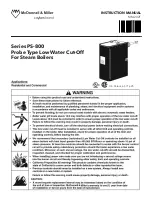
Trinity
│
Installation and Operation Instructions
Tx Series
60
16.0
ANNUAL MAINTENANCE AND INSPECTION
This unit must be inspected at the beginning of every heating season by a Qualified Technician.
Annual Inspection Checklist
1. Lighting is smooth and consistent, and the combustion fan is noise & vibration free.
2. The condensate drain freely flows, and is cleaned of sediment.
3. Relief Valve and air vents are not weeping.
4. Low water cut off is tested (if applicable)
5. Examine all venting for evidence of leaks. Ensure vent screens are cleaned and clear of debris.
6. Check the burner plate for signs of leaking.
7. The combustion chamber must be inspected and if necessary cleaned.
8. Keep boiler area clear/free from combustible materials, gasoline, and other flammable vapors and liquids.
9. Ensure there is nothing obstructing the flow of combustion and ventilation air.
10. Listen for water flow noises indicating a drop in boiler water flow rate.
Important
- The hydronic system may need to be flushed to eliminate hard water scale
(Use Fernox DS-40 Descaler, NTI PN: 83450).
11.
Verify proper operation after servicing.
Wiring Labels
- Label all wires prior to disconnection when servicing controls. Wiring
errors can cause improper and dangerous operation.
Cleansers and Potable Water
- Boiler system cleansers and corrosion inhibitors must not
be used to flush
contaminants from water heaters or potable water systems.
Combustion Chamber Cleaning Procedure
NTI recommends having the combustion chamber cleaned after the first year of operation, with subsequent
cleanings scheduled based on the condition of the combustion chamber at the time of the first cleaning. Units
operating with LP Gas or in an industrial environment may require more frequent cleanings.
Crystalline Silica
- Read carefully the warnings and handling instructions pertaining to
Refractory Ceramic Fibers before commencing any service work in the combustion
chamber. Take all necessary precautions and use recommended personal protective equipment as required.
Cleaning Checklist
1. Remove the demand for heat, allow the post-purge cycle to finish, turn gas and power supply off.
2. Working inside the cabinet, swing the control panel out of the way, disconnect the cabling to the
combustion blower, gas valve, spark igniter and flame sensor, then remove the air-inlet and gas supply
piping.
3. Once the combustion chamber has cooled, remove the four (4) nuts securing the burner assembly to the
heat exchanger, then remove the assembly (burner door, blower and gas valve) – be careful not to damage
the insulation disc located behind the burner door. Replace insulation if it is damaged.
4. Inspect the condition of the insulation at the back of the chamber; cover it to protect it from becoming wet
during the cleaning process. If the insulation is damaged, remove it and install new insulation once the
heat exchanger cleaning is complete.
5. Use a vacuum with a high efficiency filter to remove any loose debris or dust.
6. Remove the condensate trap from the bottom of the boiler and place a drain under the boiler condensate
drain.
7. Wet the inside of the combustion chamber with warm water (do not use any chemicals). Use a garden hose
with a trigger nozzle to direct pressurized water between the heat exchanger tubes; the water will exit via
the condensate drain on the bottom. Continue process until the gaps between the tubes are clear and the
water runs clean. Use dry rags or plastic to protect electrical components from being damaged by dripping
or spraying water.
8. Disassemble the condensate trap and thoroughly clean it; then reassemble and securely connect it to the
boiler condensate drain, see Section 6.0.
9. Reassemble the boiler in the reverse order of disassembly.
10. Perform the Start-up and Operational Checklist detailed in the previous section.
Replace any gaskets or insulation discs that show any signs of damage and do not re-use.
Failure to follow these instructions may result in fire, property damage or death.
















































